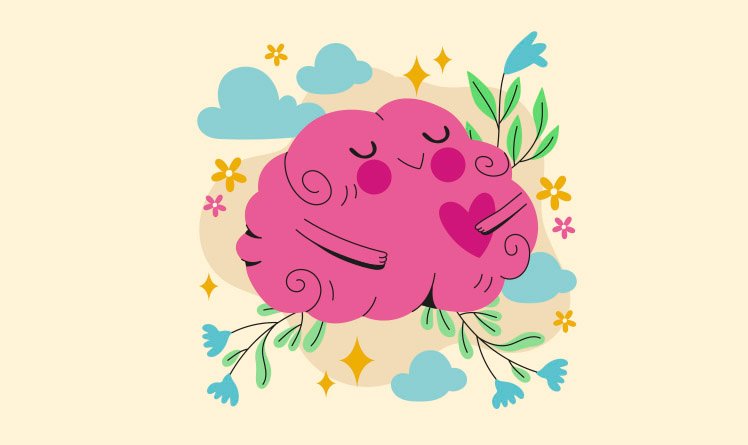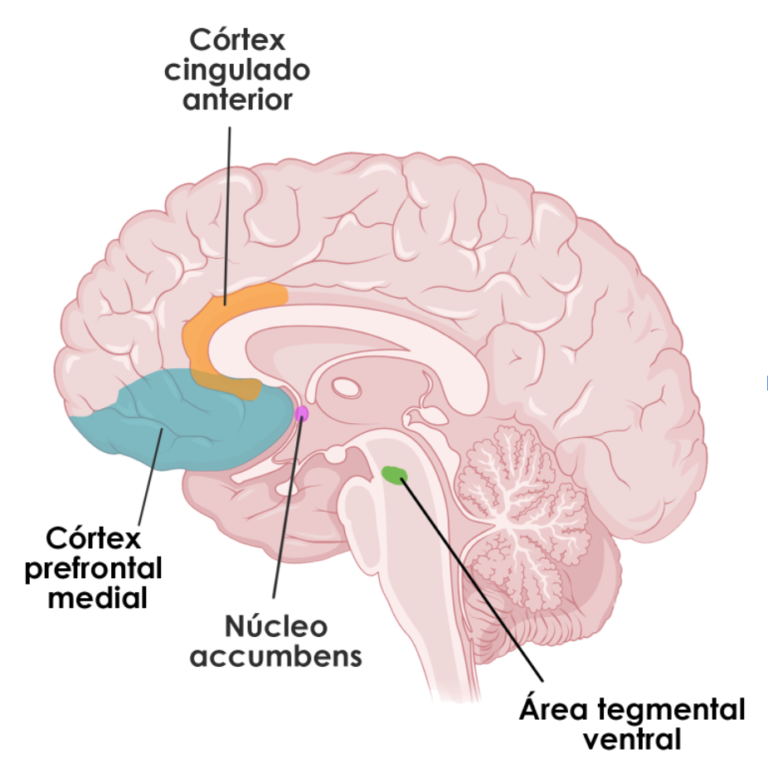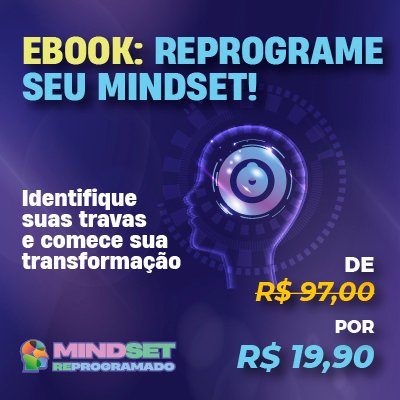Nucleus Accumbens: The Pleasure and Motivation Center of the Human Brain

|
Getting your Trinity Audio player ready...
|
There's a small region of the brain that silently decides a lot about what motivates you, what brings you pleasure, and even the behaviors you repeat every day, even when you know you shouldn't. This structure is called nucleus accumbens and although it is the size of an almond, it is one of the most powerful gears in our mind.
It's behind the feeling of pleasure when eating something delicious, the motivation to achieve a goal, and even the difficulty in giving up your cell phone or sugar. But what really happens there? And how can we "retrain" this pleasure center to find a healthier balance between satisfaction and purpose?
We'll understand the role of the nucleus accumbens and how it connects to our habits, emotions, and decisions. And, in the end, discover how to practice mindfulness and NLP can help you consciously reprogram it.
What is the nucleus accumbens and where is it located?
THE nucleus accumbens is a small structure located in the ventral striatum, within the limbic system—the set of brain regions responsible for emotions, motivation, and behavior. It is closely linked to the prefrontal cortex, amygdala and hippocampus, forming a network that balances emotion, reward and decision.
In neuroscience, the nucleus accumbens functions as a hub for pleasure and learning. Above all, it integrates signals from various parts of the brain, especially the ventral tegmental area (VTA), where dopamine, the neurotransmitter associated with pleasure, motivation, and anticipation, arrives.
“The nucleus accumbens is a region of the brain located in the limbic system that receives dopamine and participates in the regulation of pleasure, motivation and reward-based learning.”
This structure is so central that it is part of the brain's reward system: a neural circuit that makes us seek out what is good, avoid what is bad, and repeat behaviors that give us pleasure.

How the nucleus accumbens plays a role in the reward system
Imagine an internal scoring system, where your brain scores points every time you experience something pleasurable, like receiving a compliment, listening to a song you love, or completing an important task. This "scoreboard" is the reward system.
In this sense, the nucleus accumbens is the one that processes these rewards, releasing dopamine when something is perceived as pleasurable or satisfying. It's as if it tells the brain: “That was good. Do it again!”
But there's something even more fascinating: dopamine isn't released just when we experience pleasure, but before it—during the anticipation of reward. This mechanism drives us to action, creating the desire and motivation that precede pleasure.
“The nucleus accumbens is activated by both the experience of pleasure and the anticipation of it, which explains the feeling of motivation we feel before achieving something.”
Why the nucleus accumbens is the “pleasure center”
When we talk about pleasure, we're not just referring to what we feel when enjoying something good. In fact, pleasure is the result of the activation of the mesolimbic dopaminergic system, in which the nucleus accumbens is the protagonist.
So, every time we do something the brain interprets as advantageous—eating, socializing, overcoming a challenge—the nucleus accumbens lights up. It's like an internal spotlight saying: “Continue this way!”
This system, however, is trickable. Artificial stimuli—such as drugs, games, social media, and ultra-processed foods—also intensely activate the nucleus accumbens, producing rapid spikes in dopamine. However, the problem is that the brain becomes accustomed to this excess, requiring ever-increasing doses of stimuli to experience the same pleasure.
“The nucleus accumbens is considered the pleasure center because it is the main brain structure activated when we feel satisfaction and motivation—both from natural and artificial rewards.”
When pleasure becomes prison: the nucleus accumbens and addictions
The same circuit that motivates us to learn and grow can, paradoxically, imprison us. Above all, because nucleus accumbens is one of the regions most involved in compulsive and addictive behaviors.
After all, when there's an excessive release of dopamine, triggered by substances like nicotine, alcohol, cocaine, or even behaviors like social media and pornography, the brain begins to associate instant pleasure with that stimulus. Gradually, the ability to feel pleasure in simple things like talking, reading, or resting is lost.
This phenomenon is known as neuroadaptation: the brain reduces its sensitivity to dopamine, creating a kind of "emotional tolerance." The person needs more stimulation to feel the same pleasure... and the cycle of dependence begins.
Here's the key point: addictions aren't just a lack of desire, but an imbalance in the reward circuitry. Thus, the nucleus accumbens stops responding to natural pleasure and becomes controlled by artificial rewards.
“Addiction arises when the nucleus accumbens adapts to excess dopamine, becoming less sensitive and leading to the need for increasingly stronger stimuli to generate pleasure.”
The nucleus accumbens and motivation: the drive for achievement
Not all pleasure is hedonism. Thus, the same nucleus accumbens that responds to immediate rewards also activates when we work toward something greater, such as completing a project, learning a skill, or achieving a personal goal.
Similarly, motivation is the fuel that drives the dopaminergic system. Thus, it arises from the expectation of future pleasure and remains alive when the brain perceives progress. With each small advance, the nucleus accumbens releases dopamine, reinforcing the behavior and saying: “Keep going, you’re on the right track.”
That's why breaking down large goals into smaller ones is so effective. After all, each completed step generates a small neural reward, keeping the motivation cycle active.
“The nucleus accumbens is linked to motivation because it releases dopamine in response to progress and the anticipation of rewards, encouraging persistence and focus.”
Rebalancing the reward system with mindfulness and NLP
But the reward system can be retrained. And two powerful tools for this are mindfulness and Neuro-Linguistic Programming (NLP).
THE mindfulness, or mindfulness, trains the brain to perceive pleasure in small experiences, such as the taste of coffee, the sound of rain, or the sensation of breathing. Primarily, this practice strengthens the prefrontal cortex, the region that regulates the nucleus accumbens and helps reduce automatic impulses.
In this sense, observing thoughts and sensations without judgment helps us learn to break the cycle of instant reward. This way, pleasure ceases to be a compulsion and becomes awareness.
NLP offers practical tools to change the way we internally represent pleasure and motivation. Techniques such as emotional anchors and mind shifting submodalities help redirect focus to more constructive rewards such as learning, self-confidence, and purpose.
“Mindfulness and NLP help rebalance the nucleus accumbens by strengthening self-control and reprogramming the way the brain interprets pleasure and motivation.”
Conscious Pleasure and Positive Neuroscience: The Power of Achievement
Positive Psychology teaches us that there's a big difference between instant pleasure and lasting pleasure. The former is fleeting and dependent on external stimuli. On the other hand, the latter comes from fulfillment, purpose, and connection with our values.
THE neuroscience shows that activities involving purpose and altruism also activate the nucleus accumbens, but in a more balanced and sustainable way. In other words, helping someone, feeling gratitude, or achieving a goal aligned with your values generates pleasure, but without the dopaminergic crash of artificial rewards.
“Positive neuroscience shows that the healthiest pleasure arises from fulfillment and connection with personal values, activating the nucleus accumbens in a balanced and lasting way.”
Thus, when we cultivate positive emotions like gratitude, hope, and love, we create a virtuous cycle: more dopamine, more motivation, and more well-being. The brain learns that pleasure isn't just in the outcome, but in the journey.
Practical Exercise: Training the Brain for Healthy Pleasure
You can reprogram your reward system and strengthen your nucleus accumbens with a simple mindfulness and visualization exercise:
- Sit comfortably. Close your eyes and breathe deeply.
- Remember something that brought you healthy pleasure—an achievement, a heartfelt conversation, a moment of gratitude.
- Relive the scene with all your senses. See the colors, feel the atmosphere, hear the sounds.
- Notice the physical sensation of pleasure. Perhaps a warmth in your chest, an involuntary smile, a lightness in your body.
- Now, anchor that feeling. Touch your fingertips and repeat a phrase like, "I can feel pleasure in the present."
- Open your eyes slowly and bring that feeling into the now.
Repeat this exercise for three minutes daily. Over time, the brain learns to associate pleasure with the present moment, not just external rewards.
Mind Traps: How We Confuse Pleasure with Real Satisfaction
We live in an age of hyperstimulation. As a result, notifications, TV shows, promotions, and algorithms constantly compete for our dopamine. The nucleus accumbens, which evolved to reward us for survival and learning, is now bombarded with artificial rewards.
This excess creates a phenomenon many call "dopaminergic fatigue"—when nothing seems good enough. Food loses its flavor, work loses its meaning, and pleasure becomes rarefied.
But the problem isn't pleasure itself, but rather a lack of awareness of it. When we seek pleasure without presence, we enter a cycle of endless pursuit. When we experience it mindfully, it transforms into true satisfaction.
“The confusion between pleasure and real satisfaction occurs when we seek constant external stimuli and forget that true pleasure lies in the awareness of the present.”
Conclusion: rediscovering the pleasure that transforms
The nucleus accumbens is a small structure with a gigantic role: it teaches us what pleasure is, what is worth repeating, and what makes us feel alive.
But when we forget to train this system, we become hostages to dopamine, always seeking the next stimulus. True reprogramming of pleasure happens when we unite consciousness (mindfulness), self-knowledge (NLP) and positive emotions (Positive Psychology).
Therefore, by learning to feel pleasure in small achievements, in real connections and in the simple act of existing with purpose, we rebalance our reward system and regain the power to choose the pleasure that builds, not the one that imprisons.
FAQ – Frequently asked questions about the nucleus accumbens
1. What is the nucleus accumbens in simple words?
It's a region of the brain responsible for processing pleasure, motivation, and rewards. It activates when we do something the brain considers positive, such as eating, socializing, or achieving a goal.
2. What is the function of dopamine in the nucleus accumbens?
Dopamine acts as a chemical messenger that tells the brain that something has been rewarding. It is released both during pleasure and in anticipation of it, creating motivation to act.
3. How the nucleus accumbens relates to addictions
In addictions, there is an excessive release of dopamine in the nucleus accumbens. Over time, the brain adapts, requiring more stimuli to feel the same pleasure—which leads to compulsion.
4. It is possible to reprogram the brain's reward system
Yes. Mindfulness practices, NLP techniques, and healthy habits can strengthen the prefrontal cortex and retrain the nucleus accumbens, helping to balance pleasure and purpose.
5. What is the difference between pleasure and lasting satisfaction?
Pleasure is an immediate response to a stimulus; satisfaction comes from achievements aligned with values and purpose. The former is fleeting, the latter is transformative.
Images: Freepik (cover) and Neuro-Class.com

Marcel Castilho is an expert in neuromarketing, neuroscience, mindfulness and positive psychology. In addition to being an advertiser, he also has a Master's degree in NLP – Neurolinguistic Programming. As the owner and founder of the communications agency VeroCom and also of the digital agency Vero Contents, he has been studying human behavior for over 30 years.

